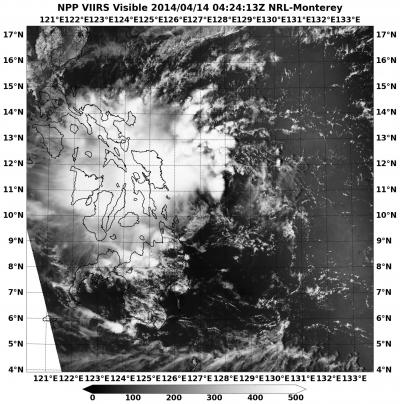NASA sees remnants of Tropical Depression Peipah over Southern Philippines

This visible image of Tropical Depression Peipah's remnants over the southern and central Philippines was taken from the VIIRS instrument aboard NASA-NOAA's Suomi NPP satellite on April 14 at 4:24 UTC/12:24. Credit: NRL/NASA/NOAA
NASA-NOAA's Suomi NPP satellite captured an image that showed Peipah's clouds covering the Visayas and Mindanao regions of the country.
The VIIRS instrument aboard NASA-NOAA's Suomi NPP satellite captured a visible look at the remnant clouds associated with former Tropical Depression Peipah on April 14 at 4:24 UTC/12:24 a.m. EDT.
The Visible Infrared Imaging Radiometer Suite (VIIRS) instrument collects visible and infrared imagery and global observations of land, atmosphere, cryosphere and oceans.
Peipah is a broad area of low pressure and its remnant clouds covered the central region of the Philippines called the Visayas region, and Mindanao, the southern region. Microwave satellite imagery confirmed that the low-level part of the storm is still poorly defined and convection (rising air that builds thunderstorms that make up a tropical cyclone) has not improved.
On April 14 at 0900 UTC/5 a.m. EDT, Peipah's remnants were centered near 9.7 north latitude and 130.8 east longitude, about 360 nautical miles/414 miles/666.7 km northwest of Zamboanga, Philippines. Maximum sustained winds were estimated as high as 20 knots/23.0 mph/37.2 kph.
According to the Joint Typhoon Warning Center, Peipah's remnants have a medium chance for regenerating in the next couple of days as it moves slowly in a westerly direction.
Media Contact
More Information:
http://www.nasa.govAll latest news from the category: Earth Sciences
Earth Sciences (also referred to as Geosciences), which deals with basic issues surrounding our planet, plays a vital role in the area of energy and raw materials supply.
Earth Sciences comprises subjects such as geology, geography, geological informatics, paleontology, mineralogy, petrography, crystallography, geophysics, geodesy, glaciology, cartography, photogrammetry, meteorology and seismology, early-warning systems, earthquake research and polar research.
Newest articles

Superradiant atoms could push the boundaries of how precisely time can be measured
Superradiant atoms can help us measure time more precisely than ever. In a new study, researchers from the University of Copenhagen present a new method for measuring the time interval,…

Ion thermoelectric conversion devices for near room temperature
The electrode sheet of the thermoelectric device consists of ionic hydrogel, which is sandwiched between the electrodes to form, and the Prussian blue on the electrode undergoes a redox reaction…

Zap Energy achieves 37-million-degree temperatures in a compact device
New publication reports record electron temperatures for a small-scale, sheared-flow-stabilized Z-pinch fusion device. In the nine decades since humans first produced fusion reactions, only a few fusion technologies have demonstrated…





















